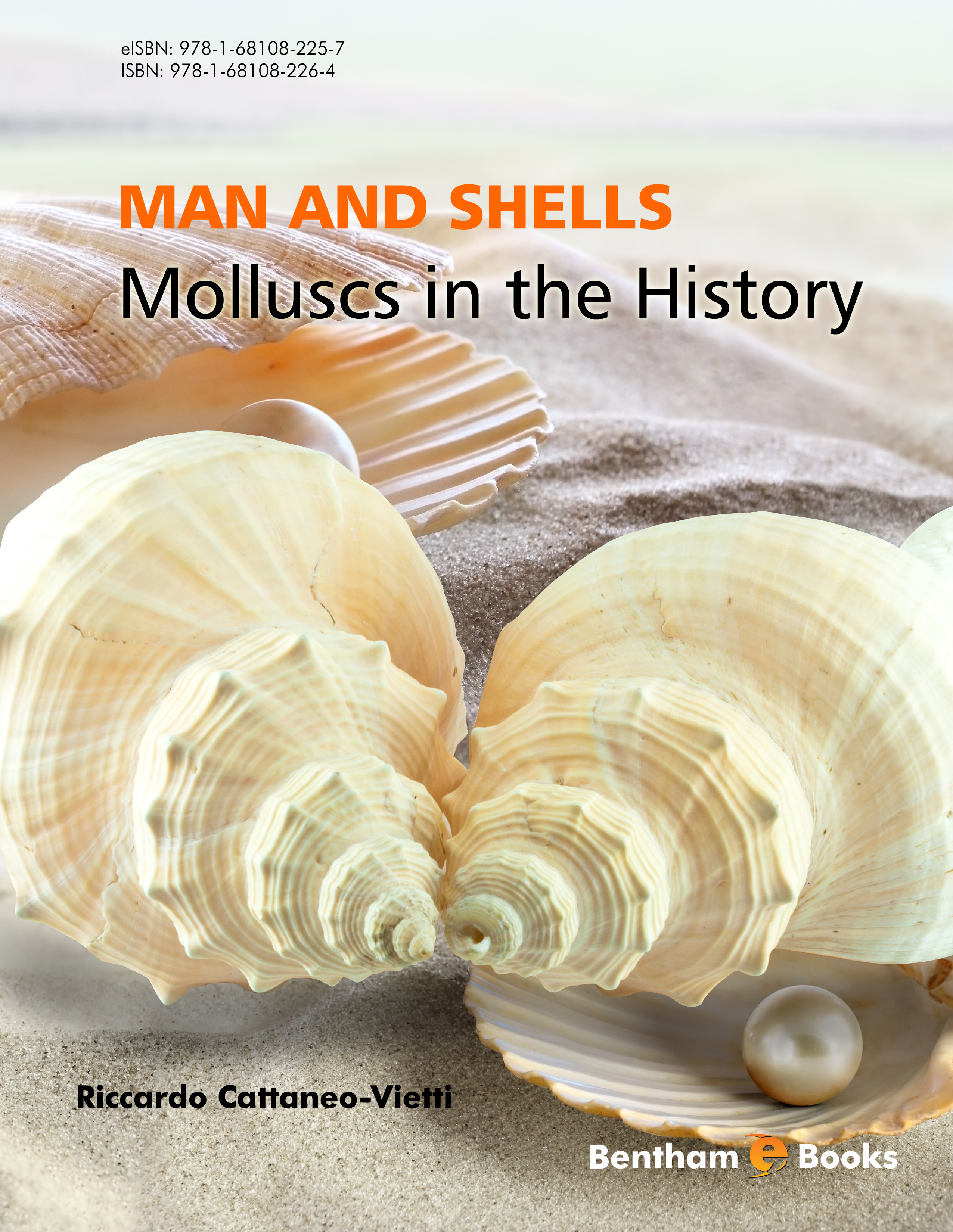All the facts in natural history, taken by themselves, have no value, but are barren
like a single sex. But marry it to human history, and is full of life.
Ralph Waldo Emerson (1803-82), Address on Nature (1836)
From the Paleolithic age to present, Molluscs have always played a role, often un-
known, in History.
Their shells show shapes and designs that have been and are still object of aston-
ishment for all and source of inspiration for the artists of all time. But not only:
sciences, medicine, religion, literature, art, jewellery, world trades, and, of course,
gastronomy, owe much to these producers of shells. They include species very
familiar to us, such as garden snails and octopuses, mussels and oysters, clams
and squids, others strange and unknown.
Today, the shellfish are major food resources for many populations: their demand
from the international market is always in growth: they are also intensively
farmed both at sea and on land, taking into account that for some "wild" popula-
tions, the threat of overexploitation is real.
Over time, the shells did not only play an important role in the material survival
of Man, but also allowed to develop his culture, taking on symbolic values of
great importance. At the dawn of history, shells assumed mythical meanings and
rituals too: objects for life and death, of high symbolic value and magical: amulets,
sexual symbols, ornaments of beauty.
Shells and Molluscs have been also a constant source of inspiration for artists:
their geometries inspired many architects, while an incredible number of painters
and sculptors of all time have copied their shapes. Since the Renaissance, the
shells are very popular, objects of desire for many, and now a hobby involving
tens of thousands of fans around the world. The shells often show such refined
beauty to arouse a sense of pleasure, an aesthetic pleasure in the myriad of pas-
sionate collectors who, in all times and in all over the world, always looking for
and preserved, sometimes in almost pathological way.
Sometimes, they were used as musical instruments: rattles and trumpets made
with shells accompanied the children to play and the rites of war and peace of many people, in at least four continents, while some cowries were “true” money
in three continents for over half a millennium.
Molluscs have had also an important role in the history of clothing: the Phoenici-
ans learned to extract purple to dye clothes from Molluscs and until the last centu-
ry in southern Italy fine "silky" tissues were made spinning the byssus from a
Mediterranean bivalve.
The contribution that Molluscs have given and continue to give to the experi-
mental biology and medicine is great. Gastropods and squids were and are still
used as lab animals: they seem to have been designed by Nature itself to facilitate
researches on neurology.
This book wants to be just a tribute to a group of organisms that, consumed as
food since prehistoric times, has always fascinated, and inspired Man, accompa-
nying him in his history: a group of organisms that has and continues to have an
important and little known place in the cultural evolution of Man.
No conflict of interest arised in this work.
Riccardo Cattaneo-Vietti
Department of Life and Environmental Sciences
Università Politecnica delle Marche (Ancona, Italy)
ACKNOWLEDGEMENTS
A special thanks to Nathalie Yonow (Swansea) and Angelo Mojetta (Milan):
without the benefits of their experience and expertise, this book would be im-
poverished both in scope and interpretation.
We are grateful to Drosos Koutsoubas (University of the Aegean, Mytilene, Gree-
ce), Simon Thrush (NIWA, New Zealand), Ester Cecere (CNR, Istituto Talasso-
grafico, Taranto), Carla del Vais (Museo Civico di Cabras, Oristano, Sardinia),
Salvatore Sebis (Oristano, Sardinia), Giorgio Bavestrello, Maria Cristina Bonci,
Antonio Guerci, Paolo Modenesi, Paolo Povero (University of Genoa), Renata
Manconi (University of Sassari), Simone Bava (MPA Bergeggi), Vanessa Bracali
(Vigo, Spain), Marino Vacchi (ISPRA, Rome), Ferdinando Boero (University of
Salento), Gian Carlo Carrada, Giovanni Fulvio Russo, Roberto Sandulli (Univer-
sity of Naples), Lorenzo Senes (Aquarium of Genoa), Carlo Ossola (Milan), Gio-
vanni Battista and Antonio Figari (Genoa), Giovanna De Rege (Rocca Grimalda,
Alessandria), Giulio Melegari (Milan), for their indispensable suggestions and
continued support during the writing.
DEDICATION:
She sells sea-shells on the sea-shore,
For if she sells sea-shells on the sea-shore
Then I’m sure she sells sea-shore shells.
Terry Sullivan, Tongue-twister (1908) inspired by Mary Anning (1799-1847), the
most famous English fossil "hunter"
Qui zase Bernardin de Ca’ Donao
Che morì in tel pescar cape de deo,
co la camisa curta e l’cul bagnato
Del Milecinquecento. Ora pro eo.
(Here Bernardin de Ca’ Donao lies. He died fishing scallops with a short shirt
and a wet ass. In the 1500 year. Pray for him)
A scallop fisherman’s epitaph in Venice (16th century)
TO GIANNI ROGHI
This book is dedicated to the memory of Gianni Roghi (1927-1967), Italian jour-
nalist, diver, photographer, mollusc expert, and curious explorer of the world.
Keen collector of shells, Roghi left us from the pages of Mondo Sommerso, the
first world magazine dedicated to diving activities, a series of articles on malacol-
ogy which were, for the youth of those times, a treasure of knowledge, research,
and inspiration.
Cover: a painted Nautilus shell from Bali, Indonesia (20th century).

